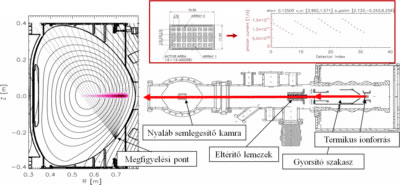The BME NTI Fusion Plasma Physics Research Group conducts its research activities in close Hungarian and international collaboration. Our work focuses on magnetic confinement fusion devices in the context of ITER and Eurofusion and as part of the Hungarian-EURATOM Fusion Association. Our fusion education is aided by our involvement in the FuseNet Association.
Our research areas reach from theoretical calculations through simulation and data processing all the way to building of plasma diagnostic equipment.
Research topics for student projects

We tailor our research topics to the specific levels and needs of applying students in the following areas:
- Beam emission spectroscopy is an important diagnostic for fusion plasmas. The basic principle of the measurement is that an accelerated atomic beam is shot into the plasma resulting in the beam atoms to be excited to high energy states in collisions with plasma electrons and ions. The photons resulting from the spontaneous emission of the beam atoms is detected, and the plasma density can thus be inferred. We model the workings of the diagnostic system using the RENATE and RENATE-OD synthetic diagnostic packages developed at NTI, and using this capability we design, build and operate such diagnostic systems around the world in close collaboration with the Fusion Plasma Physics Department of the Centre for Energy Research.
- Fusion plasmas are fascinating non-linear self-organizing dynamical systems. During experiments we frequently encounter transient behaviour, which requires specialized data processing tools. In 2011, the data processing methods developed at NTI were collected into the NTI Wavelet Tools program package also exhibiting a graphical user interface. The specialized data processing methods were mostly applied on measurements conducted at the ASDEX-Upgrade tokamak in Garching, resulting in a large number of joint publications.
- The theory-oriented work of the group is centred around the study of runaway electrons. When the plasma disrupts in a tokamak a high energy (~10 MeV) and high current (~1 MA) relativistic electron beam can form endangering the integrity of the device. Detailed simulation and design of possible mitigation methods is thus of high importance. Traditionally, we have strong collaboration in this topic with the Chalmers University, and we also have a set of our self-developed codes that we use in the EUROfusion Integrated Modelling effort.
Applications and collaboration proposals are welcome by the head of the research group, Gergo Pokol, or any other member.

